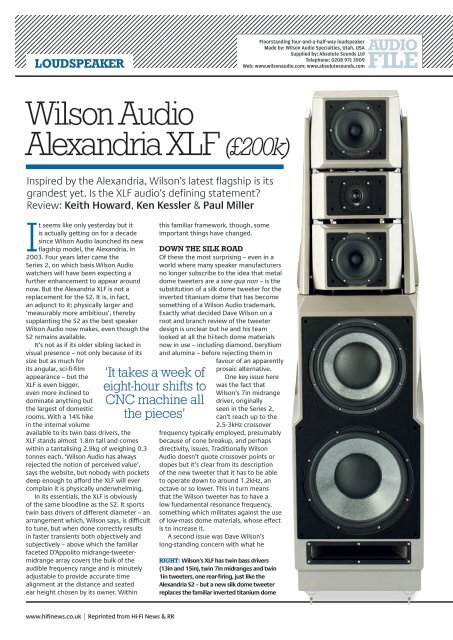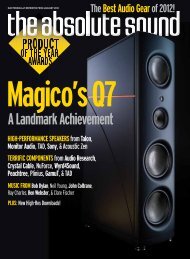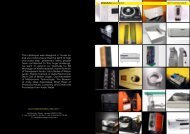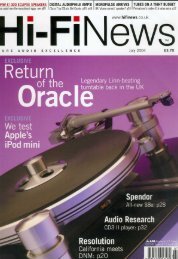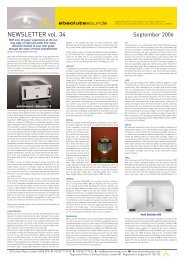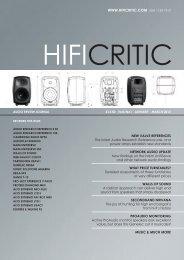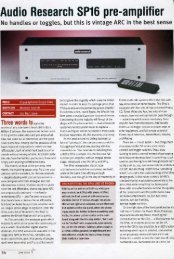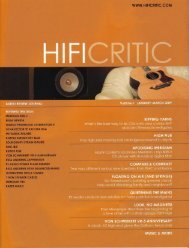loudspeaker - Absolute Sounds
loudspeaker - Absolute Sounds
loudspeaker - Absolute Sounds
Create successful ePaper yourself
Turn your PDF publications into a flip-book with our unique Google optimized e-Paper software.
LOUDSPEAKER<br />
Wilson Audio<br />
Alexandria XLF (£200k)<br />
Inspired by the Alexandria, Wilson’s latest flagship is its<br />
grandest yet. Is the XLF audio’s defining statement?<br />
Review: Keith Howard, Ken Kessler & Paul Miller<br />
It seems like only yesterday but it<br />
is actually getting on for a decade<br />
since Wilson Audio launched its new<br />
flagship model, the Alexandria, in<br />
2003. Four years later came the<br />
Series 2, on which basis Wilson Audio<br />
watchers will have been expecting a<br />
further enhancement to appear around<br />
now. But the Alexandria XLF is not a<br />
replacement for the S2. It is, in fact,<br />
an adjunct to it: physically larger and<br />
‘measurably more ambitious’, thereby<br />
supplanting the S2 as the best speaker<br />
Wilson Audio now makes, even though the<br />
S2 remains available.<br />
It’s not as if its older sibling lacked in<br />
visual presence – not only because of its<br />
size but as much for<br />
its angular, sci-fi-film<br />
appearance – but the<br />
XLF is even bigger,<br />
even more inclined to<br />
dominate anything but<br />
the largest of domestic<br />
rooms. With a 14% hike<br />
in the internal volume<br />
available to its twin bass drivers, the<br />
XLF stands almost 1.8m tall and comes<br />
within a tantalising 2.9kg of weighing 0.3<br />
tonnes each. ‘Wilson Audio has always<br />
rejected the notion of perceived value’,<br />
says the website, but nobody with pockets<br />
deep enough to afford the XLF will ever<br />
complain it is physically underwhelming.<br />
In its essentials, the XLF is obviously<br />
of the same bloodline as the S2. It sports<br />
twin bass drivers of different diameter – an<br />
arrangement which, Wilson says, is difficult<br />
to tune, but when done correctly results<br />
in faster transients both objectively and<br />
subjectively – above which the familiar<br />
faceted D’Appolito midrange-tweetermidrange<br />
array covers the bulk of the<br />
audible frequency range and is minutely<br />
adjustable to provide accurate time<br />
alignment at the distance and seated<br />
ear height chosen by its owner. Within<br />
‘It takes a week of<br />
eight-hour shifts to<br />
CNC machine all<br />
the pieces’<br />
www.hifinews.co.uk | Reprinted from Hi-Fi News & RR<br />
this familiar framework, though, some<br />
important things have changed.<br />
DOwn THE SILK ROAD<br />
Of these the most surprising – even in a<br />
world where many speaker manufacturers<br />
no longer subscribe to the idea that metal<br />
dome tweeters are a sine qua non – is the<br />
substitution of a silk dome tweeter for the<br />
inverted titanium dome that has become<br />
something of a Wilson Audio trademark.<br />
Exactly what decided Dave Wilson on a<br />
root and branch review of the tweeter<br />
design is unclear but he and his team<br />
looked at all the hi-tech dome materials<br />
now in use – including diamond, beryllium<br />
and alumina – before rejecting them in<br />
favour of an apparently<br />
prosaic alternative.<br />
One key issue here<br />
was the fact that<br />
Wilson’s 7in midrange<br />
driver, originally<br />
seen in the Series 2,<br />
can’t reach up to the<br />
2.5-3kHz crossover<br />
frequency typically employed, presumably<br />
because of cone breakup, and perhaps<br />
directivity, issues. Traditionally Wilson<br />
Audio doesn’t quote crossover points or<br />
slopes but it’s clear from its description<br />
of the new tweeter that it has to be able<br />
to operate down to around 1.2kHz, an<br />
octave or so lower. This in turn means<br />
that the Wilson tweeter has to have a<br />
low fundamental resonance frequency,<br />
something which militates against the use<br />
of low-mass dome materials, whose effect<br />
is to increase it.<br />
A second issue was Dave Wilson’s<br />
long-standing concern with what he<br />
RIGHT: Wilson’s XLF has twin bass drivers<br />
(13in and 15in), twin 7in midranges and twin<br />
1in tweeters, one rear-firing, just like the<br />
Alexandria S2 – but a new silk dome tweeter<br />
replaces the familiar inverted titanium dome<br />
Floorstanding four-and-a-half-way <strong>loudspeaker</strong><br />
Made by: Wilson Audio Specialties, Utah, USA<br />
Supplied by: <strong>Absolute</strong> <strong>Sounds</strong> Ltd<br />
Telephone: 0208 971 3909<br />
Web: www.wilsonaudio.com; www.absolutesounds.com


